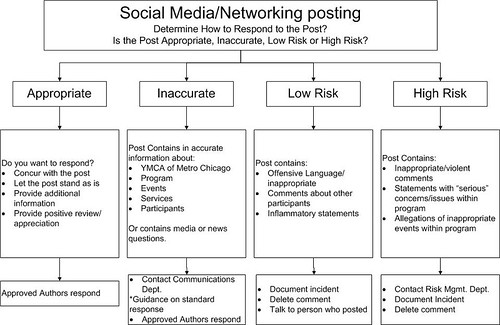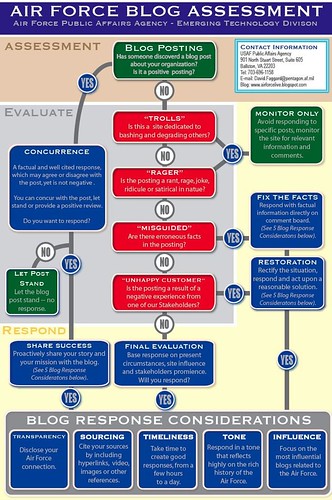
Jeremiah Owyang’s post, “Social Media Work Flow,” offers a good taxonomy for a social media work flow, triage, or process. He defines this as “a sequence of connected steps that enables the entire organization to act efficiently with minimal overlapping tasks and resources in order to serve the market in social channels and beyond.” It is the work flow documented and visualized that answers the question, “What if we get a negative comment? or on a larger scale, “What if our organization finds itself in the center of a social media backlash?” Having a work flow in place before a social media disaster strikes saves time.
It requires more than having a social media policy in place, although that is the first step no doubt. It involves discussions and buy-in from stakeholders. The product is a diagram or a series of diagrams like the one above for a large nonprofit facilitated by Steve Heye that outlines the steps.
A social work flow is part of the indicators for “Institutional Support” in the Networked Nonprofit Maturity of Practice model I shared on the SSIR blog last week and in my forth coming book, “Measuring the Networked Nonprofit.” It is definitely part of the step of getting from running to flying, especially for larger organizations. Having a good social media work flow also depends on another practice area “Listening” and the specific indicator of brand monitoring. You can see the relationship in the white paper “play book” from Radian 6, a monitoring platform.
So, how exactly do you craft one? Well, first you need a strategy and have a practice of listening in place. Then, you might ready for the nitty gritty of putting one together internally or with the help of an outside consultant.
It helps if you can see what the final product might look like. Owyang’s post points to some terrific examples including a diagram from Socialfish helped facilitate for ASCE and the class diagram from the Airforce

Owyang’s post breaks down the elements in a work flow that should be useful in helping a team write one for an organization. For example, you could lead a brainstorming session based on a realistic scenario of potential crisis and then have the team brainstorm and white board each of these elements.
- Flow control
- Crisis situations
- If then scenarios
- Ascertain situation
- Tag and flag
- First response
- Engage in public/private channel
- When not to respond
- Follow up
- Record and measure
As Alison Fine and I said in my first book, The Networked Nonprofit, social media is not a spectator sport -it is a contact sport. So, having a social media work flow allows your organization to identify, reflect, and be effective at participation.
Does your organization have a social media work flow? How did you develop it? What are your tips and best practices?

Leave a Reply